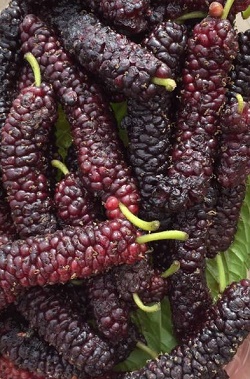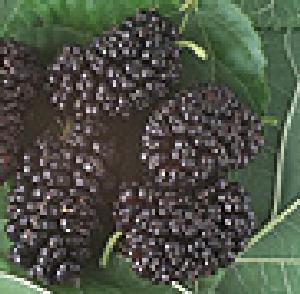
Mulberry U-Pick Orchards in Northern Vermont in 2025, by county
Below are the U-Pick orchards and farms for mulberries that we know of in this area.
Not all areas of a state have mulberries orchards that are open to the public. If you know of any others, please tell us using the add a farm form!
Remember to always check with the farm's own website or Facebook page before you go - or call or email them if they don't have a website or Facebook page. Conditions at the farms and crops can change literally overnight, so if you want to avoid a wasted trip out there - check with the farm directly before you go! If I cannot reach them, I DON'T GO!
PLEASE report closed farms, broken links and incorrect info using the "Report Corrections" form below.
New! As inflation remains high, see this page for
reliable (tested) brands of generic canning lids at lower
costs, and cost-saving measures for
getting fruit and vegetables and home canning.
If you are having a hard time
finding canning lids, I've used these, and they're a great price & ship in 2 days.
New! Road tripping and camping is a great way to have a fun, safe and inexpensive family trip. The national and state parks and monuments are open, and campgrounds usually cost between $10 and $40 per night. September to November is the best camping weather. See our new website Road Tripping and Camping.com for tips, tricks, guides, checklists and info about parks, monuments and other places to visit.
New! We just went live with our latest website, FunFactoryTours.com - As they name implies, you can find a fun factory tour, including chocolate, automobiles, historical forts and sites, famous buildings, Active Federal facilities even fun geology: like fossils and volcanic areas
Addison County
- The Last Resort - CERTIFIED ORGANIC, strawberries, red and black currants, raspberries, mulberries, blueberries
2246 Tyler Bridge Road, Monkton, VT 05443. Phone: 802-453-2847. Open: June-July. Directions: Tyler Bridge Road, Monkton. \\(Certified organic strawberries, raspberries, vegetables, pumpkins, garlic, currants\\) . Stop by the . Click here for a map and directions.
The Last Resort Facebook page. Call ahead to plan a picking date; Sometimes we have a surplus of red and black currants, raspberries, mulberries, or blueberries. When this happens, we have pick-your-own for these varieties. Follow us on Instagram and for updates. (Certified organic strawberries, raspberries, vegetables, pumpkins, garlic, currants) . Stop by the farm stand open year round, or find Last Resort products at area co-ops, small groceries, restaurants, and farmers' markets. Pick-your-own red and black currants, raspberries, mulberries, and blueberries by appointment only. Also: Fresh-picked Zucchini, eggplants, chard, beet greens and baby beets, green onions, basil, fresh garlic, garlic, snap and shelling peas, gooseberries, mulberries, currants, raspberries in the cooler. Blueberries too!. Also, non-organic maple syrup always available. (UPDATED: July 2, 2025, JBS)
[ Click here to update the listing ]
Mulberry
Mulberry Picking Tips, Recipes and Information

There are three types of mulberries commonly found: the native north American ones (black and a red variety) and the "Chinese white". The black and red (they are the color dark red, like a red delicious apple color) were native, and earlier settlers imported the white ones from China, in the hopes of getting silk worms to flourish. While no silkworms are around any longer, the berry trees are all over the place. Most people don't know they are edible. Of the three varieties, the black ones taste almost watery with a delicate sweet flavor, overall, pretty bland. The red ones are not much different, overall a great value for "free food" as they are everywhere. Beware of the little critters that are on some of them, though. The white...oh the white!! They are truly delicious, it's almost like a different fruit altogether. When ripe, they can be as long as 2", but more typically 1 1/2" long, with a slight lavender blush on the outermost part of each individual nodule that makes up the cluster of the berry. If you see some, start picking and eat them fast...they don't last long. The tiny stem at the top is hard to remove without a knife and usually just eaten. Some people add them to pancakes and muffins, simply following recipes for blueberries, however, they are best fresh just rinsed and chilled.
Mulberries typically peak during June in the South of the U.S., and in July in the north and in Canada. Crops are ready at various times of the month depending on which part of the state you are located. In order to produce good local Mulberries, producers depend on ideal spring and early summer weather conditions.
Before you leave to go to the farm:/b>
- Always call before you go to the farm - And when they are in season, a large turnout can pick a field clean before noon, so CALL first!
-
Leave early. On weekends, then fields may be picked clean by NOON!
-
Most growers furnish picking containers designed for Mulberries, but they may charge you for them; be sure to call before you go to see if you need to
bring containers.
If you use your own containers, remember that heaping Mulberries more than 5 inches deep will bruise the lower berries. Plastic dishpans, metal oven pans with 3 inch tall sides and large pots make good containers. I like the Glad storage containers like the one at right. - Bring something to drink and a few snacks; you'd be surprised how you can work up a thirst and appetite! And don't forget hats and sunscreen for the sun. Bugs usually aren't a problem, but some deet might be good to bring along if it has been rainy.
Tips on How to Pick Mulberries
- A ripe mulberry is deep purple, almost black with a plump, full feel. It will pull free from the plant with only a slight tug. If the berry is red, it's not ripe yet.
- Repeat these operations using both hands until each holds 3 or 4 berries. Repeat the picking process with both hands.
- Don't overfill your containers or try to pack the berries down.
General Picking Tips
Whether you pick Mulberries from your garden or at a Pick-Your-Own farm, here are a few tips to keep in mind:
- Pick only the berries that are fully black. Reach in between the stems to grab for hidden berries ready for harvest. Bend down and look up into the plant
and you will find loads of berries that other people missed!

- Avoid placing the picked berries in the sunlight any longer than necessary. It is better to put them in the shade of a tree or shed than in the car trunk or on the car seat. Cool them as soon as possible after picking. Mulberries may be kept fresh in the refrigerator for up to a week, depending upon the initial quality of the berry. After a few days in storage, however, the fruit loses its bright color and fresh flavor and tends to shrivel.
When you get home
- DON'T wash the berries until you are ready to use them or freeze them. Washing makes them more prone to spoiling.
- Pour them out into shallow pans and remove any mushed, soft or rotting berries
- Put a couple of days supply into the fridge, wash off the others, drain them and freeze them up! (Unless you're going to make jam right away) Mulberries are less perishable than blueberries or strawberries, but refrigerate them as soon as possible after picking. Temperatures between 34 F and 38 F are best, but, be careful not to freeze the mulberries (while they are in the fridge)!
- Even under ideal conditions mulberries will only keep for a week in a refrigerator, so for best flavor and texture, use them as soon as possible after purchase
Mulberry Recipes, Freezing and Jam directions
- How to make Mulberry jam - It is VERY easy, just like blackberry jam directions - very easy!
- How to make Mulberry jelly
- How to freeze berries
- Mulberry syrup, make and can it!
- Seedless mulberry pie!
- Mulberry Festivals: Where, When and More to Find an Mulberry Festival Near You this year:
Mulberry Facts and Tips
- Mulberries are believed to help reduce cholesterol, blood sugar, and cancer risk. They are a traditional Chinese herbal medicine
- In China, the trees are grown for their leaves as that is the only food silkworms eat.
- Mulberries are made into wine, fruit juice, tea, or jam.
- Nutritional content of fresh mulberries:
88% water
62 calories per cup (140 grams)
9.8% carbs,
1.7% fiber,
1.4% protein,
0.4% fat. - In a 3.5-ounce (100-gram) serving of fresh mulberries:
Calories: 43
Water: 88%
Protein: 1.4 grams
Carbs: 9.8 grams
Sugar: 8.1. grams
Fiber: 1.7 grams
Fat: 0.4 grams
Other Local Farm Products (Honey, Horses, Milk, Meat, Eggs, Etc.)
(NOT pick-your-own, unless they are also listed above)
- Farm markets and roadside stands
- Local Honey Finder
- Local Meat, Milk and Eggs
- Venues: Farms, Wineries, Orchards for your event, wedding or party
- Easter egg hunts
- Children"s consignment sales
- Fruit and vegetable festivals
- Winery tours and wine tastings
- Horse rides, stables, lessons, trails
- Maple Syrup farms and sugarworks
- Bed & Breakfasts on Farms, Wineries, Ranches and Orchards
- Pumpkin patches
- Corn mazes
- Zombie Paintball venues
- Christmas Tree Farms & lots
- Environmental resources
- Consumer fraud information
- Wholesale food sources
- Resources for Farmers
Looking for canning equipment and supplies?
Water bath canner with a jar rack
Pressure canners for gas, electric and induction stoves: Presto 23Qt or T-fal 22Qt
Canning scoop (this one is PERFECT)
Ball Blue book (most recent version)
Jars: 8oz canning jars for jams
Find Other types of farms:
Farm markets and roadside stands
Road trips and camping resources
Local Honey, apiaries, beekeepers
Consumer fraud and scams information
Home canning supplies at the best prices on the internet!
Maple Syrup Farms, sugarworks, maple syrup festivals
Environmental information and resources
Farms For Your Event for birthday parties, weddings, receptions, business meetings, retreats, etc.
Festivals - local fruit and vegetable festivals
Get the
most recent version of
the Ball Blue Book
With this Presto 23 quart pressure canner and pressure cooker, you can "can" everything, fruits, vegetables, jams, jellies, salsa, applesauce, pickles, even meats, soups, stews. Model 01781

You can make jams, jellies, can fruit, applesauce, salsa and pickles with water bath canners, like this Granite Ware 12-Piece Canner Kit, Jar Rack, Blancher, Colander and 5 piece Canning Tool Set

